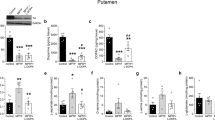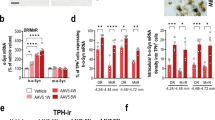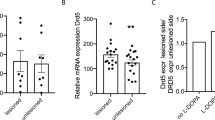Abstract
Under normal circumstances, L-dopa is converted to dopamine (DA) in DA-containing neurones of the corpus striatum by the enzyme aromatic L-amino acid decarboxylase1. Although L-dopa has been used widely to treat Parkinson's disease, the site of its decarboxylation to DA in the parkinsonian striatum is unknown. It was initially assumed that dopa administration enhances DA synthesis and release in surviving nigrostriatal neurones2–6. Subsequent in vitro studies provided evidence that exogenous dopa might also be taken up, decarboxylated7–9, and released as DA8,10 by serotonergic terminals, suggesting that non-dopaminergic neurones also may mediate some of dopa's therapeutic effects10. During long-term dopa treatment in parkinsonism, its efficacy often declines11, and diurnal fluctuations in its effectiveness (the ‘on-off’ phenomenon) can become manifest in previously responsive patients12. If the effects of dopa depend solely on surviving dopaminergic neurones, its decreasing efficacy with time could imply continuing degeneration of striatal terminals11,13. However, if exogenous dopa can also affect striatal DA transmission by being decarboxylated in serotonergic neurones, the declining therapeutic efficacy could reflect involvement of serotonergic neurones in the pathology of Parkinson's disease; this has previously been reported, but remains controversial14–17. Therefore, we examined the decarboxylation of exogenous dopa in an animal model of parkinsonism—rats with unilateral nigrostriatal lesions18—which were further subjected to lesions of the striatal serotonergic projections. Our data indicate that combined destruction of striatal dopaminergic and serotonergic terminals has little additional effect, beyond destroying dopaminergic neurones, on dopa's ability to enhance striatal DA release and do not favour the concept that serotonergic neurones are involved in mediating the therapeutic effects of L-dopa.
This is a preview of subscription content, access via your institution
Access options
Subscribe to this journal
Receive 51 print issues and online access
$199.00 per year
only $3.90 per issue
Buy this article
- Purchase on Springer Link
- Instant access to full article PDF
Prices may be subject to local taxes which are calculated during checkout
Similar content being viewed by others
References
Moskowitz, M. A. & Wurtman, R. J. New. Engl. J. Med. 293, 274–280 (1975).
Birkmayer, W. & Hornykiewicz, O. Wien. klin. Wschr. 73, 787–788 (1961).
Barbeau, A., Sourkes, T.L. & Murphy, G. in Monoamines et Systèmes Nerveux Central (ed. de Ajuriaguerra, J.) 247–262 (Georg, Geneva and Masson, Paris, 1962).
Cotzias, G. C., Papvasiliou, P. S. & Gellene, R. New Engl. J. Med. 280, 337–345 (1969).
Rinne, U. K., Sonninen, V. & Hyyppä, M. Life Sci. 10, 549–557 (1971).
Lloyd, K. G., Davidson, L. & Hornykiewicz, O. J. Pharmac. exp. Ther. 195, 453–464 (1975).
Butcher, L. L., Engel, J. & Fuxe, J. J. Pharm. Pharmac. 22, 313–316 (1970).
Ng, L. K. Y., Chase, T. N., Colburn, R. W. & Kopin, I. J. Science 170, 76–77 (1970).
Ng, L. K. Y., Colburn, R. W. & Kopin, I. J. J. Pharmac. exp. Ther. 183, 316–325 (1972).
Ng, L. K. Y., Chase, T. N., Colburn, R. W. & Kopin, I. J. Neurology 22, 688–696 (1972).
Fahn, S. & Calne, D. B. Neurology 28, 5–7 (1978).
McDowell, F. H. & Sweet, R. D. in Advances in Parkinsonism (eds Birkmayer, W. & Hornykiewicz, O.) 603–612 (Roche, Basle, 1976).
Calne, D. B. Ann. Neurol. 1, 111–119 (1977).
Bernheimer, H., Birkmayer, W. & Hornykiewicz, O. Klin. Wschr. 39, 1056–1059 (1961).
Fahn, S., Libsch, L. R. & Cutler, R. W. J. neurol. Sci. 14, 427–455 (1971).
Hornikiewicz, O. in Biochemistry and Pharmacology of the Basal Ganglia (eds Costa, E., Cote, L. J. & Yahr, M. D.) 171–181 (Raven, New York, 1966).
Rinne, U. K., Sonninen, V., Riekkinen, P. & Laaksonen, H. in Current Concepts in the Treatment of Parkinsonism (ed. Yahr, M. D.) 211–233 (Raven, New York, 1974).
Ungerstedt, U. Acta physiol. scand. Suppl. 367, 69–93 (1971).
König, F. R. & Klippel, R. A. The Rat Brain. A Stereotaxic Atlas of the Forebrain and Lower Parts of the Brain Stem (Williams and Wilkins, Baltimore, 1963).
Waymire, J. C., Bjur, R. & Weiner, N. Analyt. Biochem. 43, 588–600 (1971).
McGeer, E. G., Fibiger, H. C., McGeer, P.L. & Brooke, S. Brain Res. 52, 289–300 (1973).
Hefti, F. Life Sci. 25, 775–782 (1979).
Saavedra, J. M., Brownstein, M. & Axelrod, J. J. Pharmac. exp. Ther. 186, 508–515 (1973).
Bartholini, G., DaPrada, M. & Pletscher, A. J. Pharm. Pharmac. 20, 228–229 (1968).
Hockman, C. H., Lloyd, K. G., Farley, I. J. & Hornykiewicz, O. Brain Res. 35, 613–618 (1971).
Schoenfeld, R. I. & Uretsky, N. J. J. Pharm. exp. Ther. 186, 616–624 (1973).
Hollister, A. S., Breese, G. R. & Mueller, R. A. J. Pharmac. exp. Ther. 208, 37–43 (1979).
Schlosberg, A. J. & Harvey, J. A. J. Pharmac. exp. Ther. 211, 296–300 (1979).
Gershanik, O. S., Heikkila, R. E. & Duvoisin, R. C. Neurology 29, 553 (1979).
Glick, S. D., Jerussi, T. P. & Fleisher, L. N. Life Sci. 18, 889–896 (1976).
Kelly, P. H. in Handbook of Psychopharmacology Vol. 8 (eds Iversen, L.L., Iversen, S.D. & Snyder, S.H.) 295–331 (Plenum, New York, 1977).
Marsden, C. A. & Guldberg, H. C. Neuropharmacology 12, 195–212 (1973).
Costall, B. & Naylor, R. J. Eur. J. Pharmac. 29, 206–222 (1974).
Jacobs, B. L., Wise, W. D. & Taylor, K. M. Brain Res. 79, 353–361 (1974).
Lorens, S. A. & Guldberg, H. C. Brain Res. 78, 45–56 (1974).
Bertler, A., Falck, B., Owman, C. & Rosengren, E. Pharmac. Rev. 18, 369–385 (1966).
Lai, F. M., Udenfriend, S. & Specter, S. Proc. natn. Acad. Sci. U.S.A. 72, 4622–4625 (1975).
Owman, C. & Rosengren, E. J. Neurochem. 14, 547–550 (1967).
Oldendorf, W. H. Am. J. Physiol. 221, 1629–1639 (1971).
Duvoisin, R. C. & Mytilineou, C. Brain Res. 152, 369–373 (1978).
Author information
Authors and Affiliations
Rights and permissions
About this article
Cite this article
Melamed, E., Hefti, F., Liebman, J. et al. Serotonergic neurones are not involved in action of L-dopa in Parkinson's disease. Nature 283, 772–774 (1980). https://doi.org/10.1038/283772a0
Received:
Accepted:
Issue Date:
DOI: https://doi.org/10.1038/283772a0
Comments
By submitting a comment you agree to abide by our Terms and Community Guidelines. If you find something abusive or that does not comply with our terms or guidelines please flag it as inappropriate.



